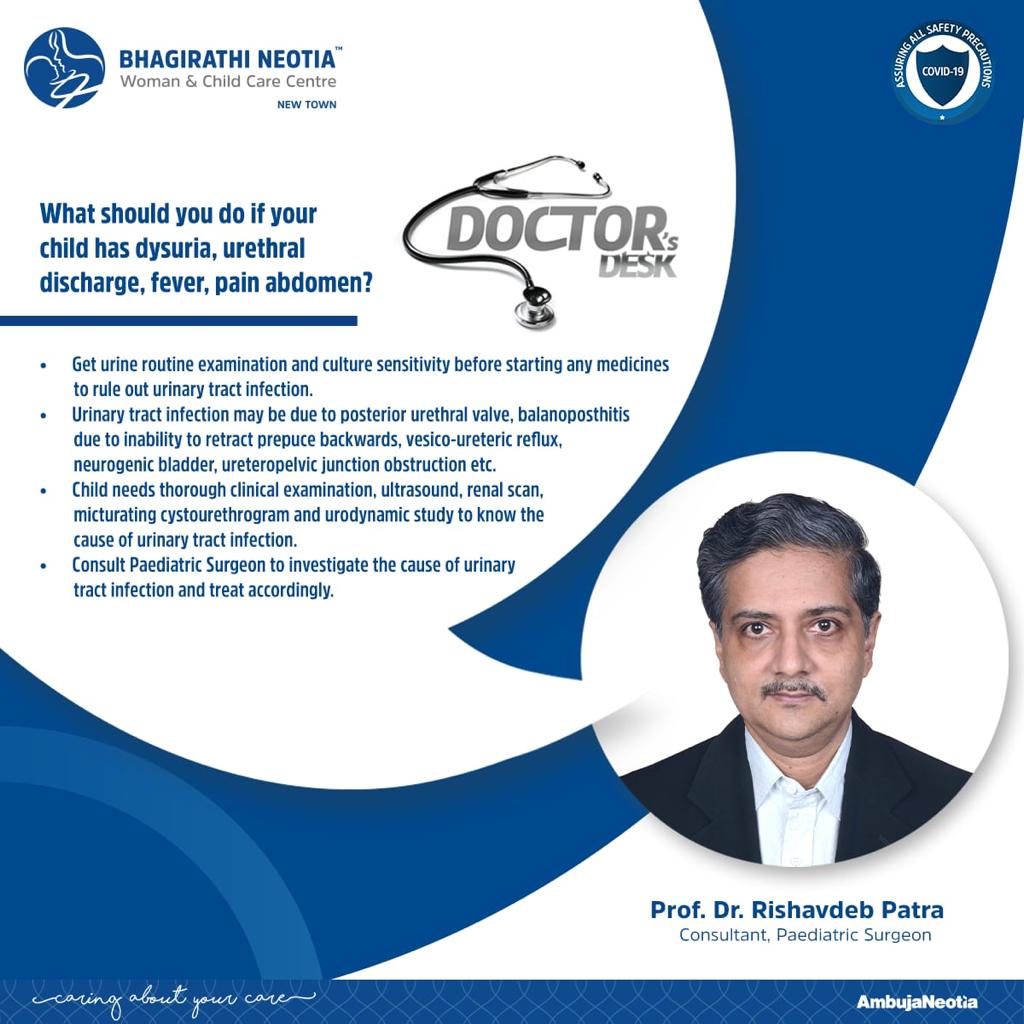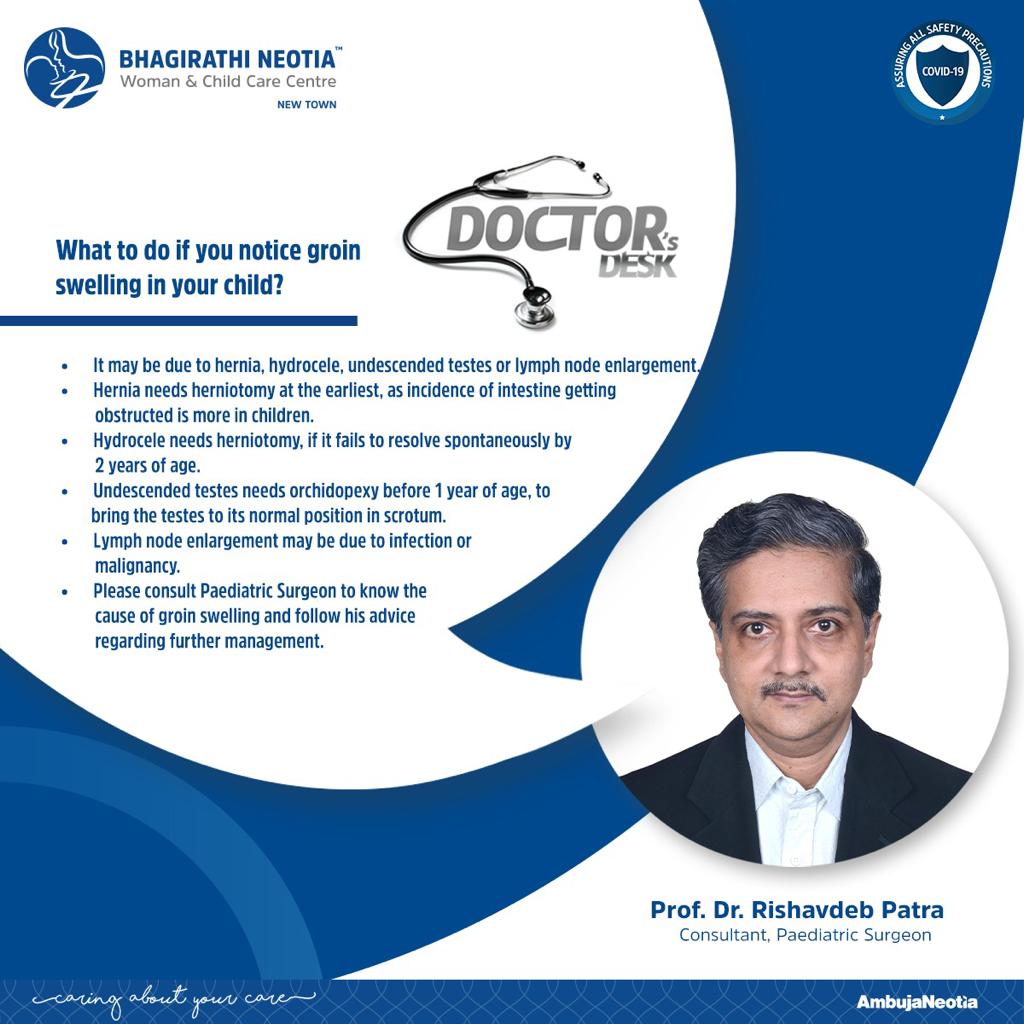Congenital Anomalies
• Haemangioma.
• Cystic hygroma.
• Branchial sinus, fistula.
• Thyroglossal cyst, fistula.
• Hypospadias.
• Posterior urethral valve.
• Hydronephrosis.
• Congenital hernia, hydrocele.
• Undescended testes.
Inguino-scrotal and Inguino-labial swellings are common in children during infancy. A common cause of an Inguino-scrotal swelling in children is the presence of a patent processus vaginalis. It presents in the form of an inguinal hernia or hydrocele. Male infants are often affected 3 to 6 times more than the female ones. Processus vaginalis is the outpouching of peritoneum that extends through the inguinal canal. It is first seen during the 3rd month of intrauterine life. It follows the gubernaculum and testes through the inguinal canal and reaches the scrotum by the 7th month of gestation.
Differential diagnosis of inguino-scrotal swelling in children:
• Inguinal hernia and hydrocele
• Torsion testes, epididymorchitis
• Undescended testes
• Varicocele
• Enlarged inguinal lymph node
• Abscess or lipoma
Normally after the testicular descent, the portion of processus vaginalis surrounding the testis becomes tunica vaginalis. The processus vaginalis gets obliterated, eliminating the communication between peritoneal cavity and scrotum. A patent processus vaginalis is seen up to 20% in adulthood.
Hernia and Hydrocele:
The testicles or ovaries form in the abdomen near the kidneys, between 3 to 4 months of fetal development. Further, they gradually move down into the lower part of the abdomen as the fetus continues to develop. On descending downwards, small part of the peritoneum (a layer of tissue lining the abdomen from inside) that attaches to the testicle is drawn with it into the scrotum. This forms a pouch or sac.
A similar process occurs in females as the round ligament of the uterus descends into the groin at the labia. The sac formed is processus vaginalis. Any connection between the abdominal cavity and the scrotum or groin is eliminated. When closure of the processus vaginalis is delayed or incomplete, it may stretch and eventually become a hernia.
Stretching of processus vaginalis creates the inguinal sac that allows organs an extension from abdomen and entry into the sac. If fluid, rather than organs, builds up and remains in the sac, the child has a hydrocele. Approximately 80 percent to 90 percent of inguinal hernias appear in boys. They are more common on the right side, but in about 10 percent of cases, they occur on both sides (bilaterally).
Epididymorchitis:
Epididymitis is the pain and swelling of the tube that attaches to each testicle called as the epididymis. Orchitis is pain and swelling of the testicle. Since epididymis and testis lie next to each other, differentiation of the inflamed part is difficult. Hence, the term epididymo-orchitis is often used. Infection with bacteria often causes these problems. Other causes are infections from surgery or from a catheter that drains urine. The mumps virus also can cause orchitis. Analgesics or anti-inflammatory medicines can reduce the pain. Antibiotics are used if the problem is caused by bacteria.
Torsion testis:
It is a painful condition that occurs in the boys. It is a twisting of the testicles and the spermatic cord (the structure extending from the groin to the testes that contains nerves, ducts, and blood vessels). A decreased blood flow to the testes is caused by torsion of the testes. This torsion essentially strangles them of oxygen and nutrients. While it generally occurs in adolescent boys, it may also occur during fetal development or shortly after a baby is born. Urgent surgical procedure is undertaken if testicular torsion is confirmed in a child. The chance of survival for the testicle is best if surgery is completed within six hours of symptom onset.
Congenial Birth Defects In Children - Know How They Can Be Managed!
Congenital birth defects include:
• Hypospadias : The opening of the urethra is located on the underside of the penis instead of the tip.
• Anorectal Malformations : The anus (which is the opening in your bottom through which stool passes through) and the rectum (which is the part of bowel immediately above the anus) have not developed properly. This occurs when the child is in the womb.
Hypospadias is a developmental anomaly characterized by a urethral meatus that opens onto the ventral surface of the penis, proximal to the end of the glans. The meatus may be located anywhere along the shaft of the penis from the glans to the perineum. Hypospadias is classified based on the position of urethral opening i.e. glanular, coronal, penile, penoscrotal and scrotal. Here the urine is deviated downwards towards the legs as the penis is bent downwards. Because of downward curvature of penis, sexual activity becomes difficult. From 6 months onwards hypospadias can be corrected by operation i.e. urethroplasty, where the opening of urethra is brought to the tip of the penis and the penis is straightened.
Anorectal Malformation : Here either there is no anal opening or it opens in a wrong place i.e. in urinary passage or birth canal in girls. It may be high anomaly or low anomaly. The immediate treatment is to make a stoma on the surface of abdomen and then do definitive pull through operation i.e. anorectoplasty when the baby is around 8 to 12 months old.
Torticollis In A Child - Know How To Manage It!
The word “torticollis” is made with the combination of two Latin words “tortus” and “collum” which mean “twisted neck.” The condition is more common in children compared to young.
Torticollis is also known as wryneck in which the head of children tilts towards one side. The condition can be easily diagnosed by a physical examination.
Types of Torticollis-
Torticollis is generally categorized into two types:
Congenital and Acquired
• Congenital Torticollis: If the child is born with
this condition, it is known as congenital muscular torticollis. It
is more common compared to acquired Torticollis. It is usually
treated with the help of physiotherapy or stretching exercises. This
helps to cure the asymmetry in the shape of the face and head.
• Acquired Torticollis: If children acquired this
condition after infancy, it is known as Acquired Torticollis. It
usually occurs after 4 to 6 months of infancy. This condition
requires immediate medical attention.
Cause of Torticollis-
Congenital torticollis occurs when the sternocleidomastoid (SCM) muscle of an infant contracts and shortens. This will cause a restriction to the mobility of the head.
Here are a few reasons why the SCM muscle become narrow and
cause this problem:
• The position of the baby in the womb
• Abnormal development of the SCM muscle
• Damage or trauma to the muscle during birth
Acquired torticollis is more severe and occurs due
to the following:
• Mild infection (usually viral)
• Minor trauma to the neck and head
• Respiratory infections of the neck
• Gastroesophageal reflux (GERD)
• Vision problems (called ocular torticollis)
• Cervical spine abnormalities like atlantoaxial subluxation
• Reaction to certain medications (called Dystonic Reaction)
• Sandifer syndrome
• Spasmus nutans
How to Manage Torticollis in a Child?
If the condition is not severe or chronic, it is easy to manage torticollis with the help of physiotherapy. There are certain exercises which help to stretch the SCM muscles and encourage the child to turn his/her child. Changing sleep position will also help a lot to manage this condition.
Other treatment and tips include:
• Turn the baby to the affected side while feeding.
• Place the toys to the affected side so that they turn.
• Let them toss and turn while playing on the bed.
• Let them play with their hands and feet.
Surgery:
Operative intervention is required if Torticollis persists beyond 12 months of age and if there is facial hemihypoplasia
Take Away
There are many treatment options available for managing torticollis. However, it is best to consult a Pediatric Surgeon first. Noticing your child carefully for the first 6 months will help to detect the condition in its early stage and hence can be cured easily.
Management Of Absent Anal Opening In A Child!
The Anorectal Malformation, also known as the imperforate anus, is
a birth defect that causes problems including:
• Absence of an anal opening.
• Abnormal position of the anal opening (or usually very small
opening).
• Fistula (Abnormal opening or connection) between the rectum and
bladder, urethra, or vagina.
• Cloaca, in which the rectum, vagina, and urethra of girl child
join together.
According to the estimation of the Cincinnati Children’s Hospital,
approximately one in every 5,000 babies has an imperforate anus or
other Anorectal Malformation. This is more common in boys as
compared to girls. It is a type of spectrum defect of anus and
rectum, which occur during the development of the baby in the womb
(usually during the fifth to seventh week of the pregnancy). With
this abnormality, the rectum and anus are not properly developed.
Causes:
When the fetus is in the womb, there are several organs developing and maturing to form an organ system. The lower part of the intestinal tract develops early (usually in the first 2- 3 months). During this period, certain steps are required for the anus and rectum to properly develop. In some cases, these steps do not occur, which should happen and cause the Anorectal Malformation.
Symptoms:
• Lack of stool due to absent anal opening
• Urine coming out from the anus
• Stool coming out from the vagina
• Difficulty in having a bowel movement
• Constipation
Management of Anorectal Malformation-
There are many treatment options available. However, it totally depends upon age, symptoms, overall health of the child, and severity of the condition. In most of the cases, the child needs to undergo the surgical procedure to treat the problem. However, the type of surgery will vary and depends upon the severity and symptoms of the child.
Some surgeries include:
• Colostomy: In this type of surgical procedure,
the ends of the large intestine are brought through an opening made
in the abdominal wall. The upper stoma makes it possible to pass the
stool through this opening. The lower stoma enables to pass the
mucus.
• Connecting the Rectum to the Anus: In this type
of surgery i.e. Anorectoplasty, the rectum is pulled through and
sutured to the new anal opening made in the normal position. Once
the surgery is done the colostomy is closed after 3 to 6 months.
Take Away Message:
The Anorectal Malformation is a birth defect and most of the children need surgery to treat this problem. However, it is always advised to consult an experienced and specialized Pediatric Surgeon for this purpose. A proper consultation will help you to choose the best option that suits you.


